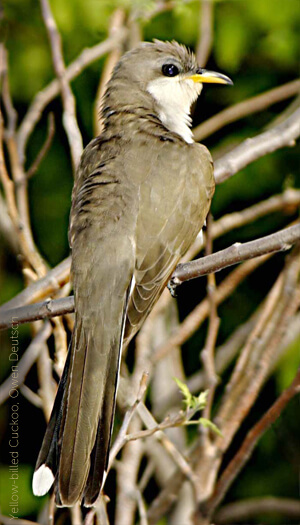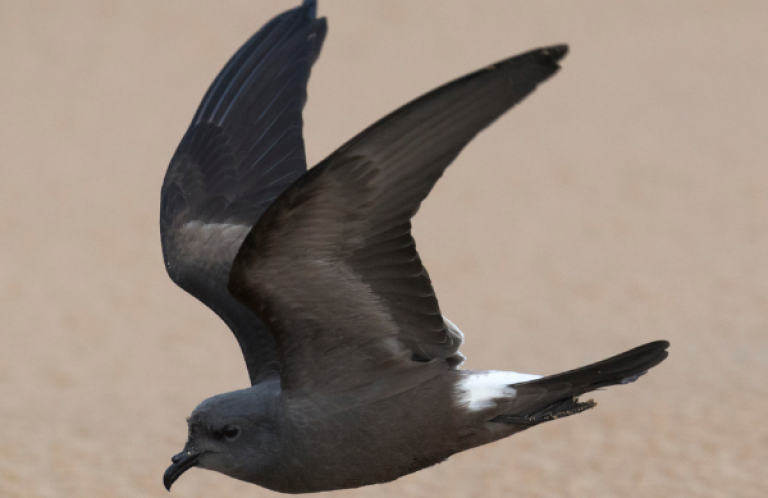Leading Bird Conservation Group Calls for Expanded Yellow-billed Cuckoo Critical Habitat
(Washington, D.C., December 17, 2014) American Bird Conservancy (ABC), one of the leading U.S. bird conservation groups, has asked the U.S. Fish and Wildlife Service (FWS) to significantly expand its proposed critical habitat designation for the western population of Yellow-billed Cuckoo, which was listed as threatened under the Endangered Species Act in October.
The request was made in a comment letter to FWS Field Director Jennifer Norris and comes on the eve of a December 18, 2014 public meeting being held on the proposal in Sacramento, California.
“There is no question that if we want to save this increasingly rare bird, we're going to have to do more than protect the bare minimum habitat. We are well past a Band-Aid fix. More aggressive action is called for in this case,” said Steve Holmer, Senior Policy Advisor at ABC.
ABC is recommending that all current and recently occupied habitat be designated as critical habitat; that FWS identify and designate critical habitat for stopover, foraging, and sheltering areas; and that FWS identify and designate critical habitat for additional unoccupied areas with the restoration potential to form large blocks of suitable cuckoo nesting habitat.
Specifically, ABC asks for critical habitat designation for 16 additional habitat patches with recent cuckoo occupancy and/or breeding activity in California, Nevada, Arizona, New Mexico, and Idaho. The ABC comments provide background information for each identified cuckoo habitat patch and describe present or historic cuckoo occupancy.
“FWS also needs to identify and designate critical habitat along the cuckoo's migratory pathways in order to address the threat of collisions with communication towers and other tall structures,” said Holmer. “Water withdrawals and riparian grazing are also major threats to cuckoo habitat and need to be more restricted than they are now. Pesticide poisoning is also a significant threat; FWS should prohibit the use of pesticides in critical habitat.”
In the United States, only 350 to 495 pairs of the bird exist, with a similar number found in Mexico. The birds are isolated in small patches of increasingly degraded riparian forest habitat that are in close proximity to human-altered landscapes, especially agriculture fields, resulting in potential for pesticides to poison individual western Yellow-billed Cuckoos and reduce their prey base.
As long-distance, nocturnal migrants, Yellow-billed Cuckoos are vulnerable to collisions with tall buildings, cell towers, radio antennas, wind turbines, and other structures. The cuckoos are known to be attracted to lights that can lead to fatal collisions. An ABC report documenting bird deaths at towers found evidence of a total of 568 Yellow-billed Cuckoo deaths at 17 towers.
Researchers have found that by extinguishing the steady-burning red lights on towers, nighttime bird fatality rates can be reduced by more than 70 percent. Birds are not as likely to be attracted to and collide with towers that are lit with only red flashing lights or white flashing lights. In December 2011, the Federal Communications Commission agreed on interim changes to their system for approving applications for new telecommunication towers.
The Yellow-billed Cuckoo has been extirpated or nearly so from most of its historical range across portions of 12 western states as well as British Columbia. There have been no recent sightings in Oregon, Washington, or Montana. In California, the population is estimated to be less than one percent of its probable historic size. Populations of fewer than 10 pairs exist in Nevada, Wyoming, Colorado, and Texas, and in Idaho and Utah only an estimated 10 to 20 pairs remain.
The extent of the cuckoo's riparian habitat loss is extreme: 90 to 95 percent in Arizona, 90 percent in New Mexico, and 90 to 99 percent in California. In Arizona, the state with largest U.S. cuckoo population, numbers have declined 70 to 80 percent in the past 30 years.



















































